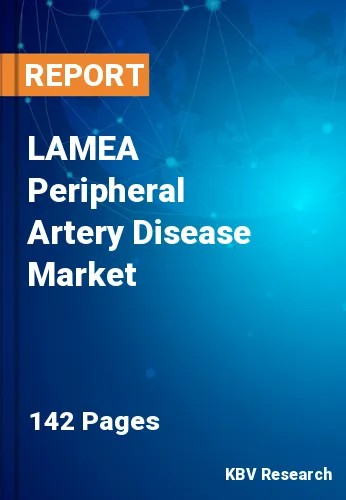The Latin America, Middle East and Africa Peripheral Artery Disease Market would witness market growth of 9.3% CAGR during the forecast period (2024-2031).
The Brazil market dominated the LAMEA Peripheral Artery Disease Market by Country in 2023, and would continue to be a dominant market till 2031; thereby, achieving a market value of $160 million by 2031. The Argentina market is showcasing a CAGR of 10.5% during (2024 - 2031). Additionally, The UAE market would register a CAGR of 9% during (2024 - 2031).

Improved awareness campaigns and advances in diagnostic techniques enable earlier disease detection, significantly impacting patient outcomes and the approach to managing PAD. One of the primary factors contributing to the rise in public awareness of PAD is the collaborative endeavor of public health organizations, medical societies, and advocacy groups to inform healthcare professionals and the general public about the disease.
Advancements in diagnostic techniques have also significantly contributed to the earlier detection of PAD. Traditional diagnostic methods, such as the ankle-brachial index (ABI) test, continue to be valuable, but newer technologies enhance the accuracy and ease of diagnosis. Doppler ultrasound, magnetic resonance angiography (MRA), and computed tomography angiography (CTA) are advanced imaging techniques that provide detailed visualizations of blood flow and arterial blockages. These tools enable healthcare providers to diagnose PAD more accurately and at an earlier stage, which is crucial for effective treatment planning.
There is an increasing demand for PAD treatment in South Africa, which is being driven by increased healthcare expenditure and improvements in healthcare infrastructure. The South African National Department of Health reports a substantial investment in healthcare services, focusing on non-communicable diseases like PAD. The prevalence of diabetes and hypertension, major risk factors for PAD, is notably high, affecting 11.3% and 44% of the adult population, respectively. Government initiatives aim to enhance early diagnosis and treatment of chronic diseases, supported by expanded healthcare facilities and improved access to medical care. Therefore, the region will present lucrative growth opportunities for market growth.
Free Valuable Insights: The Worldwide Peripheral Artery Disease Market is Projected to reach USD 7.1 Billion by 2031, at a CAGR of 6.9%
Based on Product Type, the market is segmented into Drugs (Antiplatelet Medicines, Statins, Anti Hypertensive Medication, and Others), and Devices (Peripheral Stents, Peripheral Angioplasty Balloons, Peripheral Catheters, Plaque Modification Devices, Inferior Vena Cava Filters, Hemodynamic Flow Alteration Devices, and Peripheral Accessories). Based on End User, the market is segmented into Hospitals, and Specialty Clinics.Based on countries, the market is segmented into Brazil, Argentina, UAE, Saudi Arabia, South Africa, Nigeria, and Rest of LAMEA.
By Product Type
By End User
By Country
Our team of dedicated experts can provide you with attractive expansion opportunities for your business.

